Experimental gas turbine tank "Object 288"
Back in the late fifties, Soviet tank builders began to study the subject of gas turbine engines. Such power plants - for all their complexity - made it possible to obtain a tangible increase in mobility, and also had some other advantages over "traditional" diesel engines. Over the years, a number of projects have been created, within the framework of which the possibility of using such a power plant on combat vehicles of different classes, including on tanks.
At the beginning of the sixties, the industry received new instructions for building an experienced tank with a gas turbine power plant, including two relatively low-powered engines. In accordance with the decision of the Council of Ministers of the USSR, the Leningrad Kirov Plant and the Plant. V.Ya. Klimov had to create an experimental tank and power compartment for him. In the first quarter of 1965, the main developer in the face of LKZ had to submit an experimental machine for testing.
The project received the working designation "Object 288". N.F. was appointed as the lead engineer of the pilot tank from the Kirov factory. Shashmurin. The creation of gas turbine engines and related equipment was carried out by a group of designers led by S.P. Izotov.
A preliminary version of the 288 Object project was prepared several months in advance and approved by the end of 1963. In parallel with the gas turbine tank, the Leningrad Kirov Plant designed an armored vehicle, the 287 Object, with guided missile weapons, cannons and machine guns. In order to simplify and accelerate the design process, it was proposed to use a significant number of ready-made assemblies and assemblies in the experimental design. Thus, from the point of view of construction, the new “288 Object” could well be considered a modification of the “287 Object”.
It is curious that the construction of experimental machines of two types was launched by the same order of the leadership of the defense industry. In accordance with the document issued in the last months of 1964, the LKZ was to build two experienced rocket tanks, one body of such a machine, intended for shelling tests, as well as an experimental prototype "Object 288". According to some information, the latter should have been built instead of the third “287 Object” from the same components. All required samples were completed and submitted for testing at about the same time.

The scheme of the experimental machine. Figure Solyankin A. G., Pavlov M. V., Pavlov I. V., Zheltov I. G. "Domestic armored vehicles. XX century."
Experimental armored vehicle "Object 288" to a certain extent was based on the design of the 287 Object missile tank, which, in turn, was a variant of the deep modernization of the medium tank "Object 432" (future T-64). As a result, the three cars should have similar hulls and running gears. The differences between the new prototype machine were in the cardinal renewal of the power compartment, as well as in the absence of a combat compartment with any weapons. For obvious reasons, the experimental sample was supposed to carry weaponand control equipment.
In the project with the number “288”, a slightly modified armored hull of the “287 Object” missile tank was used. This product was assembled from armor plates and non-metallic materials and had protivosnaryadnuyu protection of frontal projection. The layout remained classic, albeit adjusted for the specific role of the machine. In front of the building was placed double control room. In the place of the battle, in the center, placed the so-called. laboratory department. Feed was given to the engines and transmission. To obtain the required volumes for the power plant, the hull aft had to be lengthened by 260 mm.
The forehead of the hull retained the combined protection that withstood the impact of any armor-piercing and cumulative projectiles of the time. This barrier consisted of 90-mm steel sheet, two fiberglass plates with a thickness of 130 mm, as well as a pair of steel parts with a thickness of 15 and 30 mm. Inside the armor was supplemented with a special lining. Boards and feed had a thickness of no more than 50-56 mm. On top of the case was covered 20-mm armor. To enhance protection, the frontal part was located at a large angle to the vertical.
On the roof of the hull, on top of the standard shoulder strap of the tower, they proposed to place a special cabin for observation of the terrain and natural lighting of the laboratory section. The cabin was made in the form of a conical dome with a curved roof. Along the perimeter of the conical bead was a large number of glasses. On the left on the wheelhouse was located a hatch for access inside. As can be judged, the dome of the laboratory compartment served as ballast, but could not be made of armored steel.
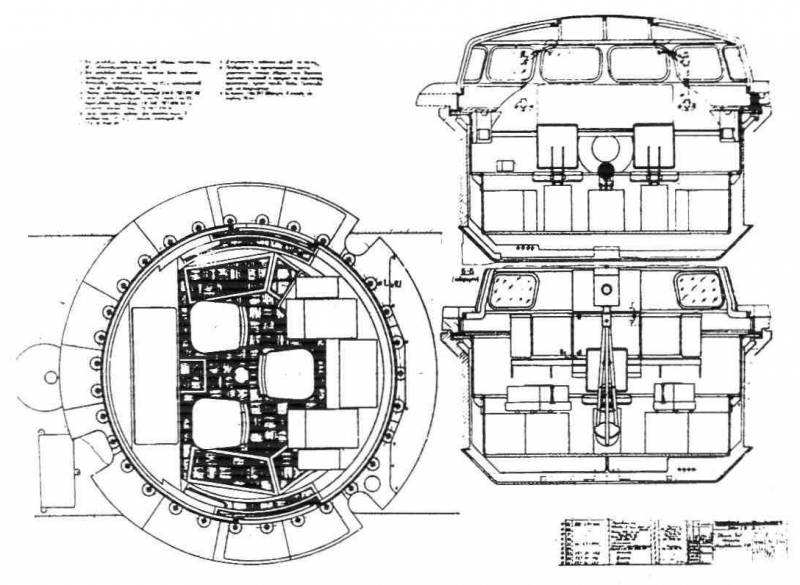
The scheme of the laboratory department. Figure Solyankin A. G., Pavlov M. V., Pavlov I. V., Zheltov I. G. "Domestic armored vehicles. XX century."
A new type of power plant was placed in the engine-transmission compartment. In accordance with the terms of reference, "Object 288" was to be equipped with two gas turbine engines working on a common transmission. In the stern, across the hull, a pair of GTD-350T engines was installed. Two such products created on the basis of aviation engines GTD-350, developed a power of 400 hp. In connection with the installation of a heat exchanger, the power of each engine was reduced to 390 hp. The total power of the power plant was 750 hp, which is why it was actually the equivalent of one GTD-700 engine.
One of the engines was equipped with an electric starter that could be used to start the entire power plant. Both engines were equipped with heat exchangers, with the help of which it was planned to increase efficiency. With the help of a bevel gear coupling equipped with an electric drive, the engines could be connected to the transmission or disconnected from it. Thus, at the same time a tank could use one or two engines, depending on the current situation. Inside the hull placed fuel tanks on the 900 l of fuel, outside of it - two tanks on the 180 l.
The tank received a mechanical planetary transmission with metal-ceramic friction discs operating in oil and frictional gears. Each board had a gearbox and gearbox. Both boxes and gearboxes had a planetary architecture. The transmission was controlled by hydraulic servo drives. Also in the control system of the power plant introduced a pair of levers responsible for the supply of fuel to each of the engines. Thus, when turning, it was possible not only to slow down the track, but also to reduce the speed of the corresponding engine.
The electrical system of the “288 Object” was built on the basis of the SG-12T generator, which also served as a starter for engine starting. In addition, the tank received four 12CT-70 rechargeable batteries.
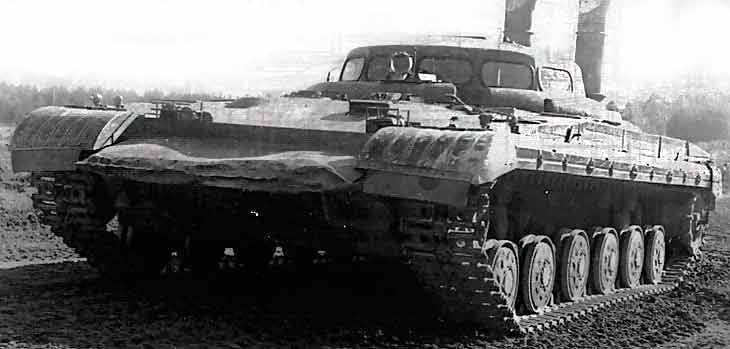
The tank is on trial. The power plant is equipped with air pipes. Photo Zonwar.ru
The chassis, in general, was based on aggregates of the medium tank “Object 432”. Inside the case, torsion bars of the independent suspension of six pairs of road wheels were fixed on the bottom. In front of the hull were guide wheels, in the stern - leading. The latter were developed anew, taking into account the hull shape of the onboard gearboxes. The chassis has retained four supporting rollers on each side and small side screens covering the upper branch of the track. The caterpillar itself, as in the previous tanks, had a parallel-type rubber-metal hinge.
Experimental tank "Object 288" had no weapons. In place of the fighting compartment of the base machines placed the laboratory compartment. It had monitoring and recording equipment necessary for tracking the work of the new power plant. Watch the testimony had three engineers, each of which had its own seat.
To simplify the assembly, an experienced tank of a new type retained the unit's control of the 287 Object rocket engine. In front of the hull, in front of the laboratory compartment, there was a double control compartment with a pair of hatches in the roof. For obvious reasons, only one of the two places was used, intended for the driver. He could follow the road through the open hatch or with the help of several viewing devices.
The use of the existing hull, which has undergone minimal modifications, made it possible to keep dimensions and weight at the level of previous samples. Experienced tank "Object 288" had a total length of about 6,4 m with a width of 3,4 m and a height of no more than 1,7 m. Curb weight - 36,5 t. On a highway, the car could reach speeds of up to 66 km / h. When one engine is running, the power reserve provided by the tanks with a total capacity of 1260 l was 450 km. Two engines allowed to pass only 340 km.
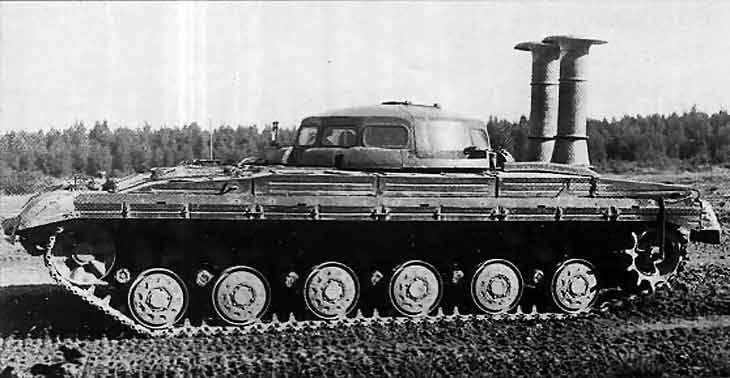
View of the port side. Photo Zonwar.ru
It should be noted that the project "Object 288" was considered as the basis for a promising rocket tank. In this case, instead of the laboratory compartment should use the fighting compartment with a swivel tower. The dome of the latter was supposed to have a small height and be equipped with advanced onboard units. In the center of the tower was proposed to place two retractable launchers for missiles, on the sides - a pair of semi-automatic guns. The main weapons of such a tank were considered missiles "Lotos", "Rubin" and "Astra". With the help of such a weapon, capable of making 1-2 shots per minute, it would be possible to hit targets at distances up to 4 km. Ammunition, depending on the type of complex, could consist of 30-35 guided missiles.
The project of a rocket tank based on the experimental "Object 288" was worked out, but did not receive development. A large-scale mock-up of such a combat vehicle was made, but the project did not progress further. The refusal of such a project was associated with the lack of serious success at the base “288 Object”, as well as with a change in the military’s views on the missile armament of armored vehicles.
In accordance with the established work schedule, the Leningradsky Kirovsky Zavod at the beginning of XXUMX presented for testing an experimental tank with a gas turbine power plant. This machine was built almost simultaneously with two prototypes of the “1965 Object”. The finished sample was sent to the landfill for verification in real conditions. Tests of the tank were carried out at different ranges with different conditions and continued until the fall of 287. During this time, a large amount of information was collected on the operation of the new power plant on various routes and in differing conditions.
During the tests, the “288 Object” was once again confirmed the fundamental possibility of equipping the tank with a gas turbine engine. One of the main advantages of such a system was to save space: two gas-turbine engines occupied only 1,68 cubic meters - noticeably less than a diesel of similar power. At the same time, there were no real layout advantages over a single gas turbine engine of a given power. Given certain problems, due to the sufficient complexity of the power plant and transmission, the “288 Object” showed good results in terms of mobility in all landscapes and, at least, was not inferior to other equipment.
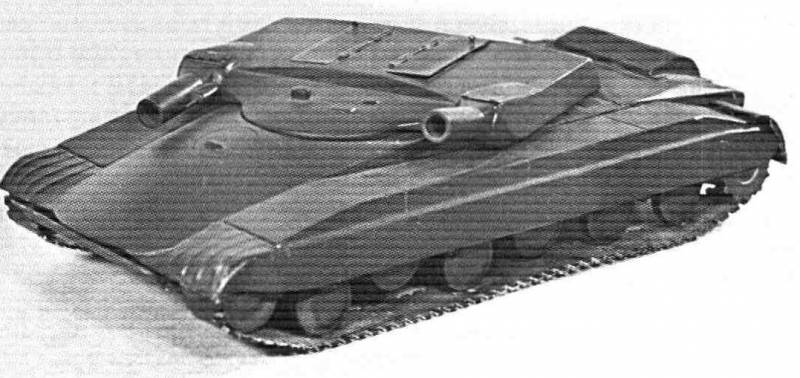
The layout of the "Object 288" with a tower and weapons. Photos Solyankin A. G., Pavlov M. V., Pavlov I. V., Zheltov I. G. "Domestic armored vehicles. XX century."
At the same time there were serious problems. Thus, the resource of the GTE-350T engine did not exceed 200 hours, which interfered with the normal operation of the tank. The power compartment as a whole, characterized by sufficient complexity, was prone to breakdowns and did not provide the desired ease of maintenance. Finally, it was found that a power plant based on a pair of engines has no real advantages over a single motor of comparable power. Thus, when using a single engine type GTE-700, the “288 Object” could have the same technical characteristics with a certain simplification of operation.
Experienced tank "Object 288" passed the tests and showed all its capabilities, allowing to determine the real prospects of the original idea of using a twin engine installation. She had certain disadvantages, and besides, she did not show any clear advantages over other variants of power sections. The project solved its problem and was of no more interest. In 1967-68, all work on it was discontinued.
According to the test results, the project was closed. Among other things, work was stopped on the creation of a new combat compartment with rocket and cannon weapons. The rocket-gun version of the "288 Object" remained in the form of a layout and a set of technical documentation.
The experimental gas turbine tank that was no longer needed was left for storage. Later he got into the museum of armored vehicles in the town of Kubinka. There is a unique car to this day. It is curious that the experienced "288 Object" with a characteristic cutting room of the laboratory department is located in the exhibition pavilion next to the prototype of the "287 Object", on the basis of which it was created.
For the study of various issues related to equipping armored vehicles with gas turbine power plants, a variety of experimental machines were required. One of the proposals in this area was implemented and studied in practice with the help of an experienced tank "Object 288". This car showed its characteristics and capabilities, as well as clearly demonstrated the existing potential. The main ideas of this project did not justify themselves, and therefore the experimental tank was the only one of its kind. New projects of combat vehicles with gas turbine engines were based on other solutions.
Based on:
http://tankmuseum.ru/
http://dogswar.ru/
http://otvaga2004.ru/
http://btvt.info/
Solyankin A. G., Pavlov M. V., Pavlov I. V., Zheltov I. G. Domestic armored vehicles. XX century. - M .: Exprint, 2010. - T. 3. 1946 – 1965.
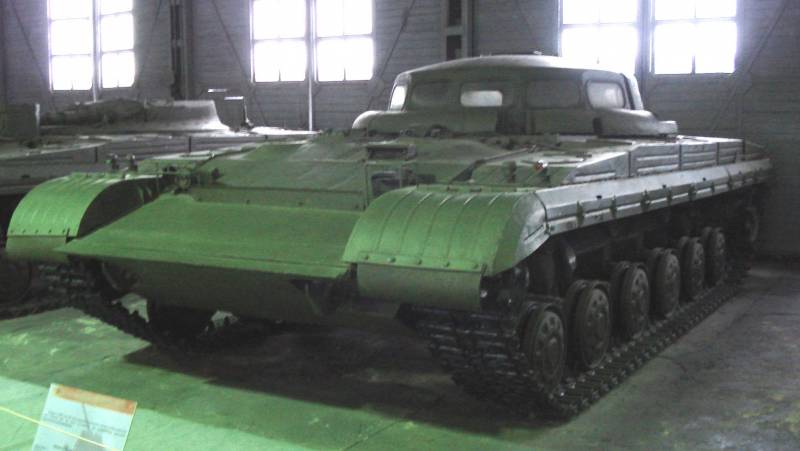
Information